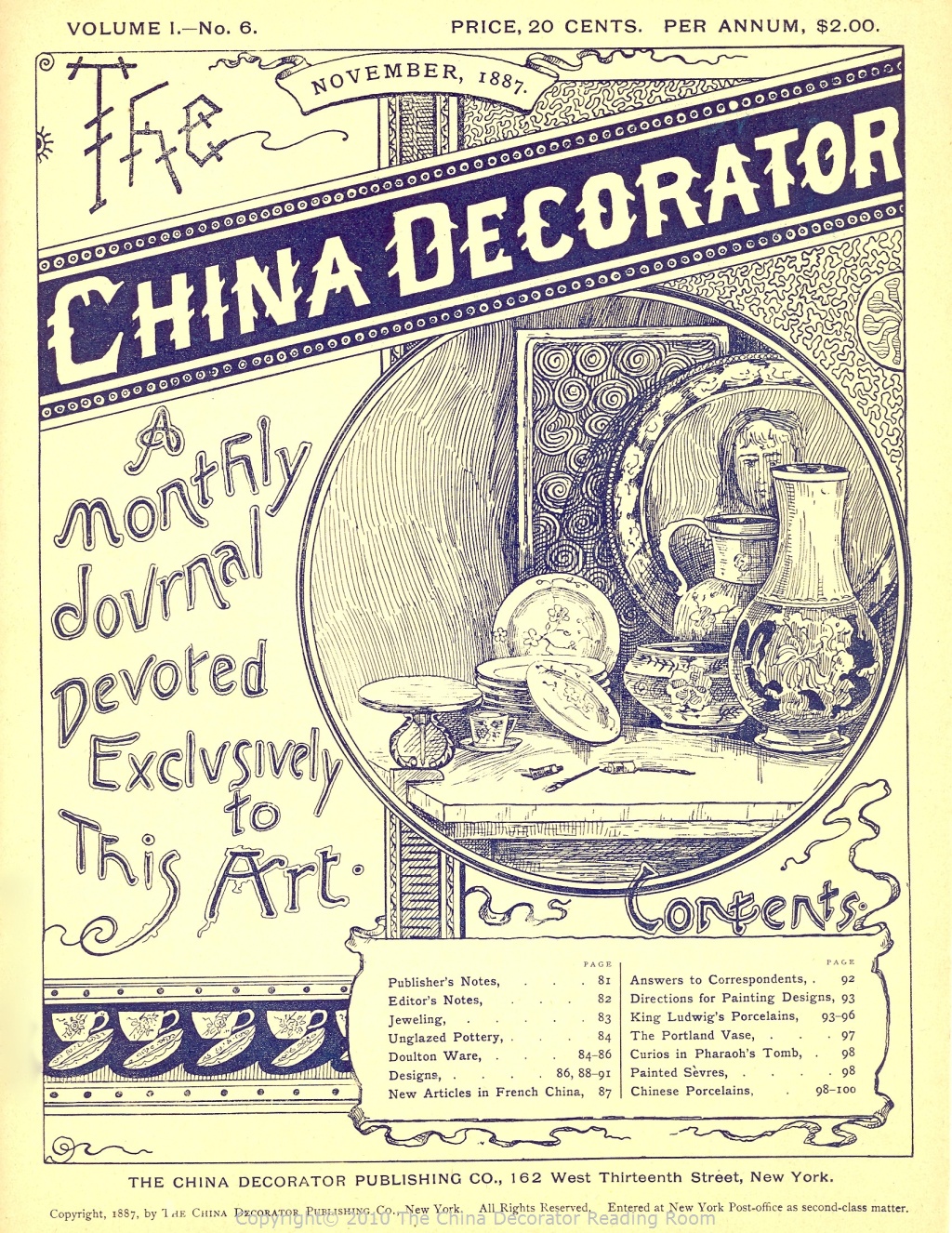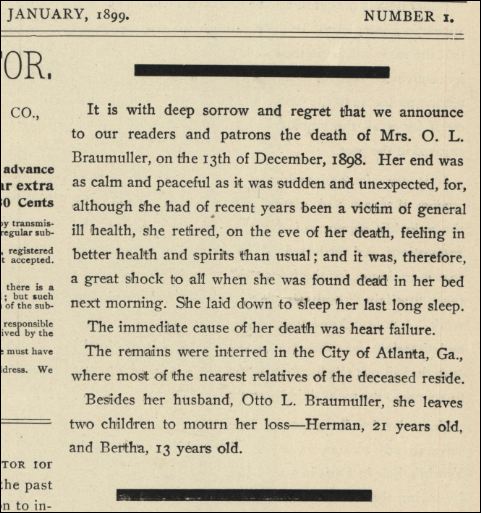Luetta Braumuller's earliest recollections were closely allied to the pencil and brush, and at the age of eight years she received her first instruction in art. During most of her life, with the exception of a few short intervals, she has applied herself to the study of drawing and painting in all its branches.
In 1880, she made her first trip to Europe and remained nearly a year in the best studios of Berlin. And upon her return taught large classes in all branches of ceramic art. In 1882, she made a second visit to Paris and Sevres, where she studied porcelain painting under celebrated ceramic artists. Later that same year, she continued with a noted practical china and glass painter in Berlin.
In 1889, she went to Dresden, where she acquired a knowledge of the methods of the Dresden artists. In 1890, she was again in Paris, where she pursued the study of flesh-painting after the method of Mme. Hortense Richard. Mrs. Braumuller was distinctly a figure painter, although she had a complete knowledge of every branch of work connected.
In 1882, she published a small work entitled "Lessons in China Painting." However, over the next five years she came to believe that a periodical would have a wider circulation and give better results.
So in 1887, she established a monthly magazine devoted entirely to the interests of amateur china decorators. Known as the "The China Decorator, A Monthly Journal Devoted Exclusively to this Art", it was a success from the very first issue in June 1887 and enjoyed a wide circulation both in the United States and in Europe. It was a publication that was eventually endorsed by the best china painters in almost every country around the globe.
At the Woman's Progress Congress, held in May 1893, during the Chicago World's Fair, she was appointed to represent ceramics and their relation to home life. She was also invited to accept a similar position at the Art Congress, held in August of the same year, but was unable to accept either.
In 1893, Luetta was listed in A Woman of the Century, a book featuring 1,470 biographical sketches and portraits of leading American women in all walks of life.
Luetta was the wife of Otto L. Braumuller, a well-known 19th century piano manufacturer in New York City and was the mother of two children, a son Herman and daughter Bertha. Illness during her later years compelled Mrs. Braumuller to give up all work not absolutely necessary and connected with the magazine.
After her untimely death on Dec 13, 1898, at the age of 42 years and 9 days, the magazine was continued for a year by her husband and son. However, the duties proved too arduous and imposed on their other business interests. So at the dawn of the new century, The China Decorator was sold to George Thiell Long. Mr. Long, already a publisher, promised his readers to continue the magazine as the recognized authority in its field.
The new publisher's wife, Mrs. Adelaide Husted Long, who served as the late Mrs. Braumuller's editorial assistant, continued on as Editor. During the last few years of Mrs. Braumuller's life, Mrs. Long gave much invaluable assistance with the editorial work at the magazine.
At the end of the 19th Century, her magazine, The China Decorator, was the recognized authority in all matters pertaining to china and glass painting and decorating, as well as water color painting. Unfortunately, on the threshhold of the 20th century, The China Decorator ceased publication. The last issue published was May/June 1901. It was widely rumored that the magazine was sold to Samuel and Adelaide Robineau who transformed it into Keramic Studio magazine.
The China Decorator Reading Room is a website devoted to preserving Luetta's magazine and to celebrating her contributions to the fine art of painting on porcelain. This website is free to the public and can be found at TheChinaDecoratorReadingRoom.org.
Luetta Braumuller's earliest recollections were closely allied to the pencil and brush, and at the age of eight years she received her first instruction in art. During most of her life, with the exception of a few short intervals, she has applied herself to the study of drawing and painting in all its branches.
In 1880, she made her first trip to Europe and remained nearly a year in the best studios of Berlin. And upon her return taught large classes in all branches of ceramic art. In 1882, she made a second visit to Paris and Sevres, where she studied porcelain painting under celebrated ceramic artists. Later that same year, she continued with a noted practical china and glass painter in Berlin.
In 1889, she went to Dresden, where she acquired a knowledge of the methods of the Dresden artists. In 1890, she was again in Paris, where she pursued the study of flesh-painting after the method of Mme. Hortense Richard. Mrs. Braumuller was distinctly a figure painter, although she had a complete knowledge of every branch of work connected.
In 1882, she published a small work entitled "Lessons in China Painting." However, over the next five years she came to believe that a periodical would have a wider circulation and give better results.
So in 1887, she established a monthly magazine devoted entirely to the interests of amateur china decorators. Known as the "The China Decorator, A Monthly Journal Devoted Exclusively to this Art", it was a success from the very first issue in June 1887 and enjoyed a wide circulation both in the United States and in Europe. It was a publication that was eventually endorsed by the best china painters in almost every country around the globe.
At the Woman's Progress Congress, held in May 1893, during the Chicago World's Fair, she was appointed to represent ceramics and their relation to home life. She was also invited to accept a similar position at the Art Congress, held in August of the same year, but was unable to accept either.
In 1893, Luetta was listed in A Woman of the Century, a book featuring 1,470 biographical sketches and portraits of leading American women in all walks of life.
Luetta was the wife of Otto L. Braumuller, a well-known 19th century piano manufacturer in New York City and was the mother of two children, a son Herman and daughter Bertha. Illness during her later years compelled Mrs. Braumuller to give up all work not absolutely necessary and connected with the magazine.
After her untimely death on Dec 13, 1898, at the age of 42 years and 9 days, the magazine was continued for a year by her husband and son. However, the duties proved too arduous and imposed on their other business interests. So at the dawn of the new century, The China Decorator was sold to George Thiell Long. Mr. Long, already a publisher, promised his readers to continue the magazine as the recognized authority in its field.
The new publisher's wife, Mrs. Adelaide Husted Long, who served as the late Mrs. Braumuller's editorial assistant, continued on as Editor. During the last few years of Mrs. Braumuller's life, Mrs. Long gave much invaluable assistance with the editorial work at the magazine.
At the end of the 19th Century, her magazine, The China Decorator, was the recognized authority in all matters pertaining to china and glass painting and decorating, as well as water color painting. Unfortunately, on the threshhold of the 20th century, The China Decorator ceased publication. The last issue published was May/June 1901. It was widely rumored that the magazine was sold to Samuel and Adelaide Robineau who transformed it into Keramic Studio magazine.
The China Decorator Reading Room is a website devoted to preserving Luetta's magazine and to celebrating her contributions to the fine art of painting on porcelain. This website is free to the public and can be found at TheChinaDecoratorReadingRoom.org.
Family Members
See more Braumuller or Bumstead memorials in:
- Oakland Cemetery Braumuller or Bumstead
- Atlanta Braumuller or Bumstead
- Fulton County Braumuller or Bumstead
- Georgia Braumuller or Bumstead
- USA Braumuller or Bumstead
- Find a Grave Braumuller or Bumstead










